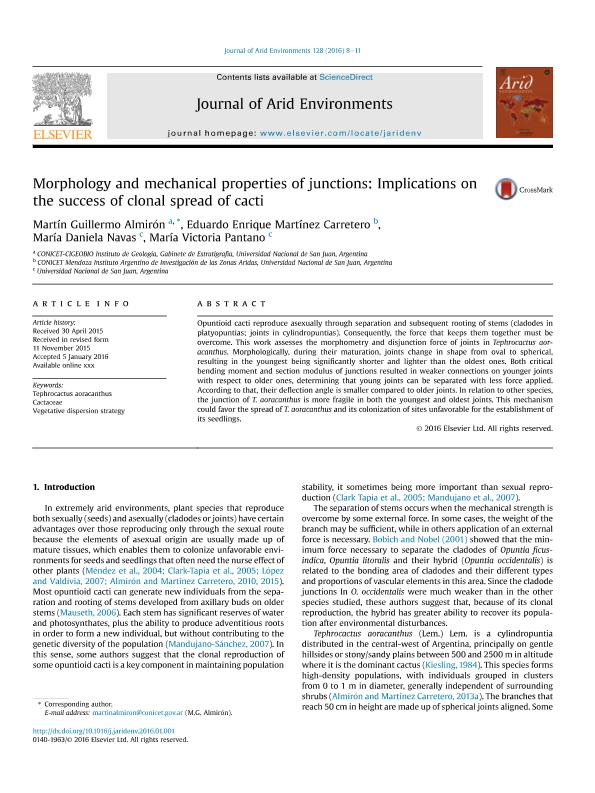Mostrar el registro sencillo del ítem
dc.contributor.author
Almiron, Martin Guillermo

dc.contributor.author
Martinez Carretero, Eduardo Enrique

dc.contributor.author
Navas, María Daniela
dc.contributor.author
Pantano, Victoria
dc.date.available
2018-05-18T20:12:51Z
dc.date.issued
2016-04
dc.identifier.citation
Almiron, Martin Guillermo; Martinez Carretero, Eduardo Enrique; Navas, María Daniela; Pantano, Victoria; Morphology and mechanical properties of junctions: Implications on the success of clonal spread of cacti; Academic Press Ltd - Elsevier Science Ltd; Journal of Arid Environments; 128; 4-2016; 8-11
dc.identifier.issn
0140-1963
dc.identifier.uri
http://hdl.handle.net/11336/45649
dc.description.abstract
Opuntioid cacti reproduce asexually through separation and subsequent rooting of stems (cladodes in platyopuntias; joints in cylindropuntias). Consequently, the force that keeps them together must be overcome. This work assesses the morphometry and disjunction force of joints in Tephrocactus aoracanthus. Morphologically, during their maturation, joints change in shape from oval to spherical, resulting in the youngest being significantly shorter and lighter than the oldest ones. Both critical bending moment and section modulus of junctions resulted in weaker connections on younger joints with respect to older ones, determining that young joints can be separated with less force applied. According to that, their deflection angle is smaller compared to older joints. In relation to other species, the junction of T. aoracanthus is more fragile in both the youngest and oldest joints. This mechanism could favor the spread of T. aoracanthus and its colonization of sites unfavorable for the establishment of its seedlings.
dc.format
application/pdf
dc.language.iso
eng
dc.publisher
Academic Press Ltd - Elsevier Science Ltd

dc.rights
info:eu-repo/semantics/openAccess
dc.rights.uri
https://creativecommons.org/licenses/by-nc-sa/2.5/ar/
dc.subject
Tephrocactus Aoracanthus
dc.subject
Cactaceae
dc.subject
Vegetative Dispersion Strategy
dc.subject.classification
Otras Ciencias Biológicas

dc.subject.classification
Ciencias Biológicas

dc.subject.classification
CIENCIAS NATURALES Y EXACTAS

dc.title
Morphology and mechanical properties of junctions: Implications on the success of clonal spread of cacti
dc.type
info:eu-repo/semantics/article
dc.type
info:ar-repo/semantics/artículo
dc.type
info:eu-repo/semantics/publishedVersion
dc.date.updated
2018-04-18T17:52:51Z
dc.journal.volume
128
dc.journal.pagination
8-11
dc.journal.pais
Estados Unidos

dc.journal.ciudad
Amsterdam
dc.description.fil
Fil: Almiron, Martin Guillermo. Consejo Nacional de Investigaciones Científicas y Técnicas. Centro Científico Tecnológico Conicet - San Juan. Centro de Investigaciones de la Geosfera y Biosfera. Universidad Nacional de San Juan. Facultad de Ciencias Exactas Físicas y Naturales. Centro de Investigaciones de la Geosfera y Biosfera; Argentina
dc.description.fil
Fil: Martinez Carretero, Eduardo Enrique. Consejo Nacional de Investigaciones Científicas y Técnicas. Centro Científico Tecnológico Conicet - Mendoza. Instituto Argentino de Investigaciones de las Zonas Áridas. Provincia de Mendoza. Instituto Argentino de Investigaciones de las Zonas Áridas. Universidad Nacional de Cuyo. Instituto Argentino de Investigaciones de las Zonas Áridas; Argentina
dc.description.fil
Fil: Navas, María Daniela. Universidad Nacional de San Juan; Argentina
dc.description.fil
Fil: Pantano, Victoria. Universidad Nacional de San Juan; Argentina
dc.journal.title
Journal of Arid Environments

dc.relation.alternativeid
info:eu-repo/semantics/altIdentifier/doi/http://dx.doi.org/10.1016/j.jaridenv.2016.01.001
dc.relation.alternativeid
info:eu-repo/semantics/altIdentifier/url/https://www.sciencedirect.com/science/article/pii/S0140196316300015
Archivos asociados
